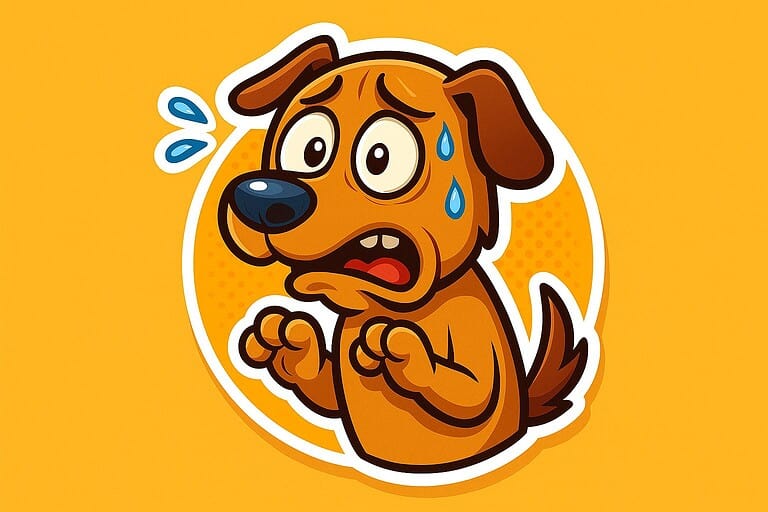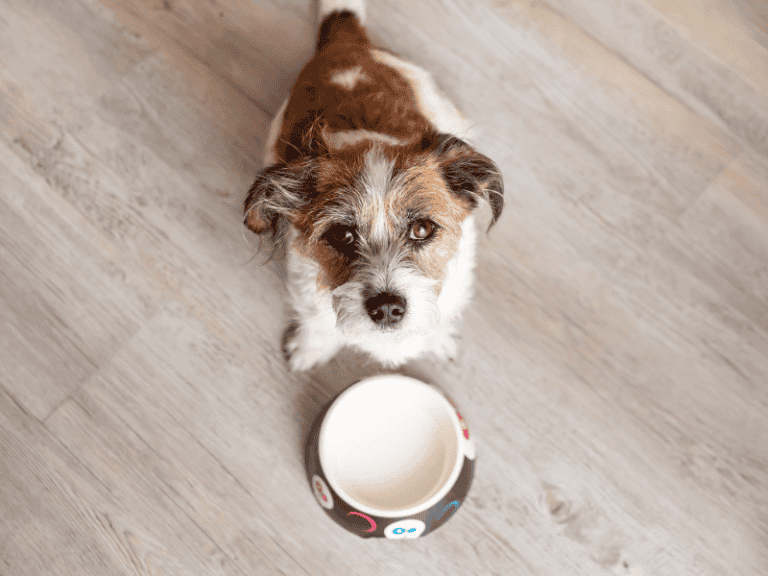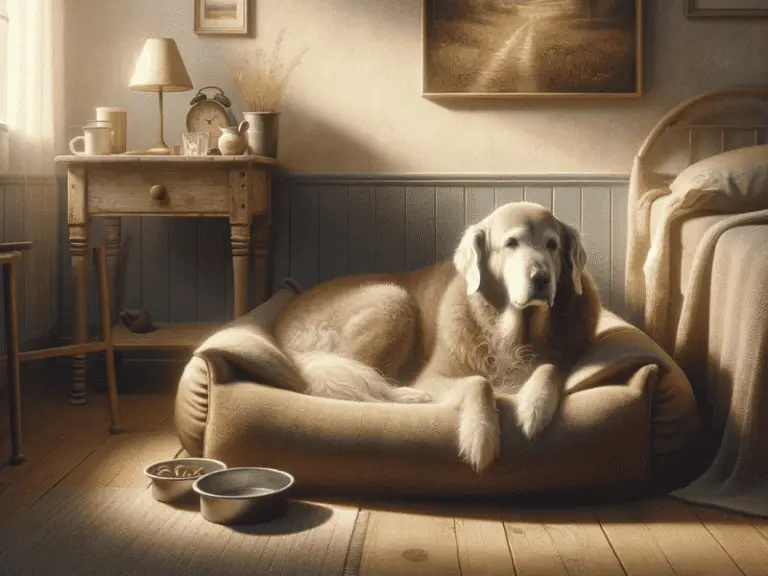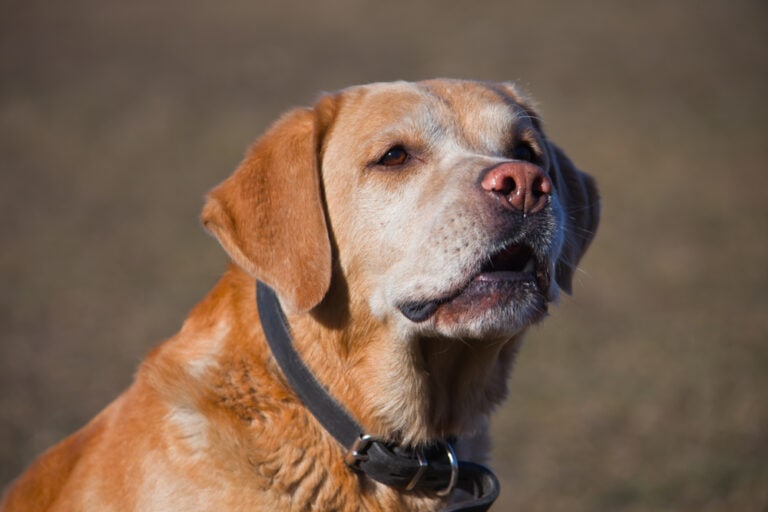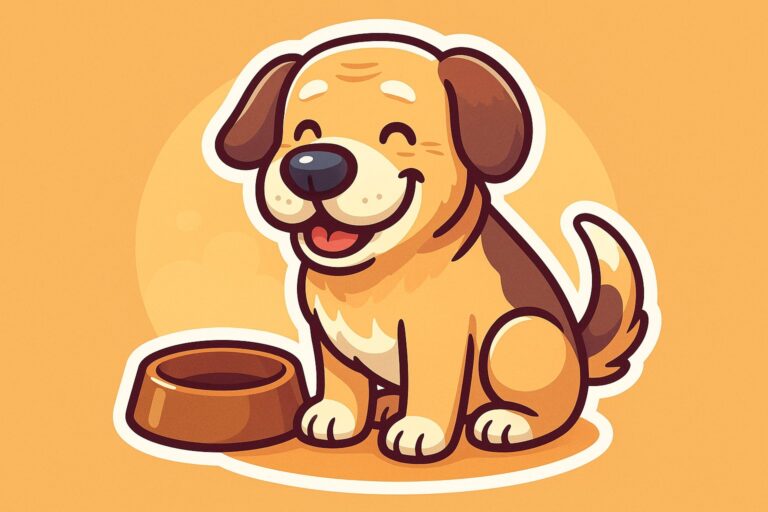7 Proven Strategies to Help Your Senior Dog Lose Weight
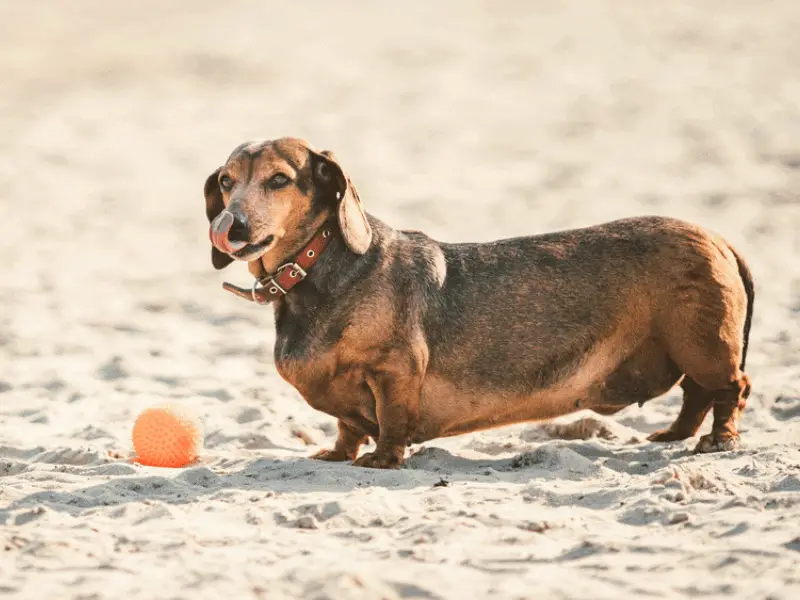
According to the German Association for Animal Health, almost every second dog in Germany is overweight. With increasing weight, the risk for certain diseases rises. At the same time, life expectancy decreases.
To make sure your senior dog stays healthy for as long as possible, you should definitely pay attention to maintaining a healthy body weight. For dogs, this means you should be able to feel their ribs with gentle pressure.
If you look down at your dog from above while he’s standing, you should be able to clearly see his waist. The fluffier your four-legged companion is, the harder this may be to tell, though.
You’ll find out how to prevent and fight overweight in senior dogs in the following six points.
📑 Tip #1: Have your dog checked by a vet
Before you start tackling your senior’s excess weight directly, you should pay a visit to your vet. This is especially important with older dogs. There are certain illnesses that can cause weight gain, even if your dog isn’t eating too much.
These conditions don’t only affect senior dogs, but are more common in them. As you can read on the website of veterinarian Dr. Hölter, weight gain can also be caused by
- an underactive thyroid,
- Cushing’s disease, and
- hormonal disorders caused by malfunction of the sex glands,
A diet wouldn’t help your dog in cases like this at all. First, you need to know the underlying cause of his weight gain. Then you can tackle the problem.
The vet appointment will also help you determine the right course of action when it comes to weight loss. For example, if your dog is suffering from joint issues, you shouldn’t put too much emphasis on extra exercise.
You should also discuss any changes in diet with your vet.
Older dogs need a different nutritional make-up. If your companion has pre-existing conditions, he may already be on a special diet. In that case, you shouldn’t switch foods without talking to your vet first.
📑 Tip #2: Determine your dog’s energy needs
Most dogs weigh much less than their human companions. Accordingly, they also need far less energy to get through the day. As they age, their energy requirements change again.
Because seniors lose muscle and become less active, they need fewer calories to maintain their weight. So, even if your dog has been eating the same food in the same portions for years, he may start gaining weight now.
To find out how many calories your dog needs per day, use this formula: (Dog’s body weight * 30) + 70.
This gives you his basal metabolic rate—the number of calories he burns just lying in his bed doing nothing. The more active he is, the more calories he’ll need on top of that.
For the average senior dog, you can use this formula: Basal metabolic rate * 1.6. This results in the following table for energy needs:
- Senior dog weighing 10 kg: 592 calories per day
- Senior dog weighing 20 kg: 1,072 calories per day
- Senior dog weighing 30 kg: 1,552 calories per day
Keep in mind, however, that these are really just average values. Your dog’s actual needs will depend on so many factors that it’s impossible to calculate them precisely.
If your dog needs to lose weight, he’ll need to eat fewer calories than he burns. At the same time, you still have to cover his basal metabolic rate with food—otherwise, he’ll lose weight too quickly, which can also be harmful for seniors.
📑 Tip #3: Get the whole family involved
The best diet is useless if your senior keeps getting spoiled by other family members. Treats often contain 400 calories per 100g—or even more. For a small dog, just a handful of treats can mean his dinner needs to be a whole lot smaller.
So, inform everyone who feeds your dog about your plan. Ideally, you’ll give them a healthy alternative right from the start. Otherwise, they’ll quickly fall back into old habits—especially with your dog looking up at them with those big, pleading eyes. Not giving him a treat can feel almost cruel!
Another approach is to set aside a portion of your dog’s daily ration to be used as treats. In the morning, weigh out the total amount of food your dog should get throughout the day. Take a part of it and put it where you would normally store his treats. Of course, this only works with dry food.
This way, everyone in the household can grab from the treat supply. Whatever’s left in the evening just gets added to his dinner.
📑 Tip #4: Soak his food
Many dogs love food that has been soaked in water. For seniors, this tip is especially helpful, as it also puts less strain on their teeth. As Martin Florian Buck writes, already by the age of two, 80% of all dogs suffer from periodontitis.
Tartar and other dental problems that make chewing difficult become much more common with age. If your dog is too old for anesthesia to solve these issues, you need to find another way to help him.
One way to help is to soak his food. The water increases the food’s volume, making your dog feel full longer. The water fills his stomach and keeps him satisfied.
This way, your dog won’t be hanging out in the kitchen begging for food just half an hour after breakfast.
Alternatively, you can soak the food in homemade meat or vegetable broth. Both are virtually calorie-free and add some flavor.
📑 Tip #5: Feed healthy snacks
As I already mentioned, everyone in your household needs to pull together so your senior can shed some pounds. So, put away all the unhealthy dog biscuits and offer healthy snacks instead.
Dogs can eat many types of vegetables raw. These include carrots, cucumbers, and kohlrabi (though you should only feed kohlrabi in moderation, as it can cause gas). All three are very low in calories.
If your dog isn’t a fan of raw veggies, try giving him
- cottage cheese,
- watermelon, or
- small dried fish (be sure to check the calorie info on the package).
If you want to bake something healthy for your dog yourself, it’s really easy. Use up leftover egg whites to make meringue. Beat the egg white until stiff and stir in some herbs. Fill the mixture into a piping bag and pipe out small dots onto a piece of baking paper.
Alternatively, you can use two teaspoons to dollop out larger meringues onto the baking sheet. Bake the meringues until they’re completely dry at about 100°C (210°F). Depending on the size, this can take several hours.
Another great idea: ice treats for dogs! The simplest version is frozen unsalted chicken broth. For a large senior, you can put an entire frozen block in the yard. He’ll happily lick and chew at it without actually taking in many calories.
📑 Tip #6: The right kind of exercise for older dogs
Older dogs often suffer from osteoarthritis—a degenerative joint disease brought on by aging. As a result, our furry friends experience pain during movement and may even refuse to go for walks.
If your dog has arthritis, he’ll first need painkillers and anti-inflammatory medication. Your vet will decide whether other treatments or injections with hyaluronic acid are possible.
Next, it’s important to keep your dog moving anyway. Otherwise, the affected joints may stiffen, eventually making it impossible for your dog to walk at all.
However, it’s essential that exercise is as gentle on the joints as possible. Don’t let your dog off the leash to chase after birds. With effective pain meds, he might even try this, even with advanced arthritis.
Instead, your furry friend should be allowed to swim or walk in water. Some veterinary clinics or holistic practitioners offer underwater treadmills for this purpose. Your dog stands in warm water up to his chest and exercises his muscles without damaging his joints.
Typically, a training session lasts 20 to 30 minutes. Depending on the clinic, it will cost around 30 to 50 euros per session.
It’s also typical with arthritis that affected dogs walk better in the evenings than in the mornings. When they’re at rest, the pain is worse. Once your dog has moved around a bit, things get easier for him. So, take your dog outside for a brief potty trip in the morning. Later on, once he’s loosened up, you can go for a longer walk.
📑 Tip #7: Change his diet—instead of just cutting portions
As your senior gradually needs less energy, you’ll have to adjust his food intake. But an almost empty food bowl won’t make your dog happy. If he only needs two bites to finish dinner, he’s likely to feel hungry still.
That’s when the begging starts—and some dogs even turn to stealing, even as they get older. If you drop something edible, it barely hits the floor before your dog has snapped it up.
To avoid this, it’s often better to gradually switch your dog to a new food, rather than just serving less and less. After all, just reducing portions not only cuts calories, but also essential vitamins and minerals your senior needs.
What matters is that you use a high-quality food tailored to seniors. Take your time when switching foods.
Older dogs are prone to digestive troubles when they get something unfamiliar to eat. Gradually replace more and more of his old food with the new one.
Follow the feeding instructions on the package and weigh your dog regularly. If your dog has allergies or is on a special diet due to a pre-existing health issue, be sure to consult your vet before making any changes.
Conclusion
A healthy weight is important at any age. It helps prevent secondary diseases and provides your dog with a degree of protection against joint wear and tear. Because age-related issues make life especially hard for senior dogs, you should always keep a close eye on your older dog’s weight.
Be gentle when it comes to weight loss, and always bear your dog’s advanced age in mind. The right food in the right amount is key here. Your senior won’t be able to lose weight through exercise alone—movement now serves more to maintain his muscle mass.
When in doubt, ask your vet for advice. He or she should always be your first point of contact in cases of sudden weight gain, too.

